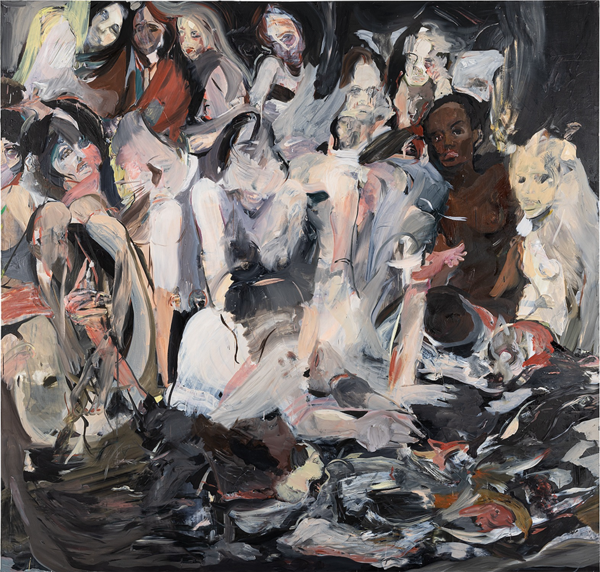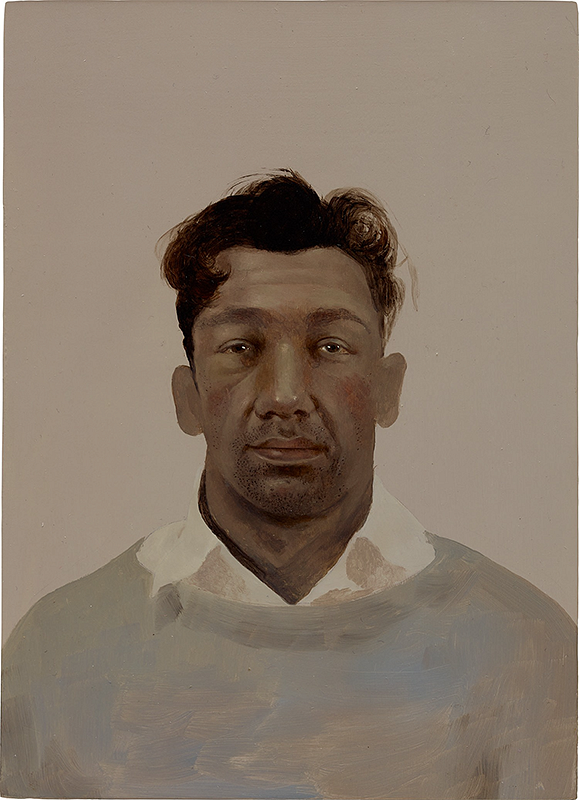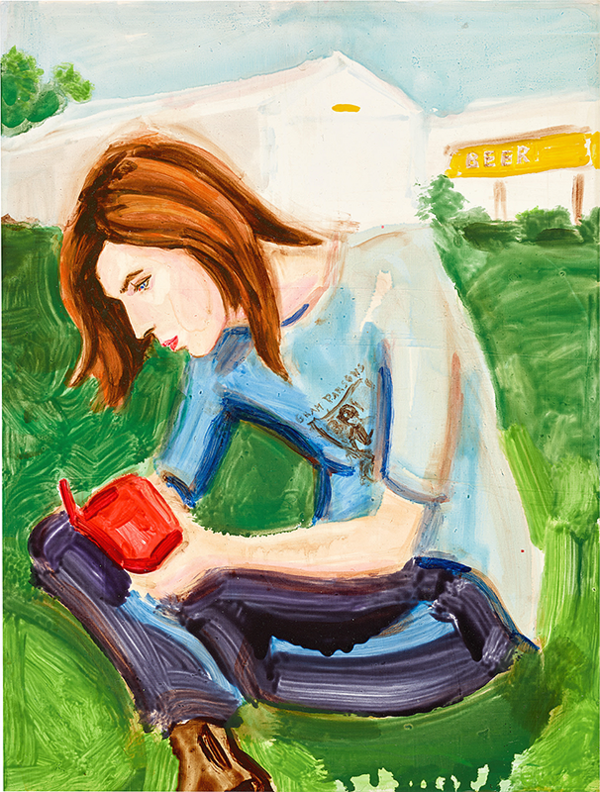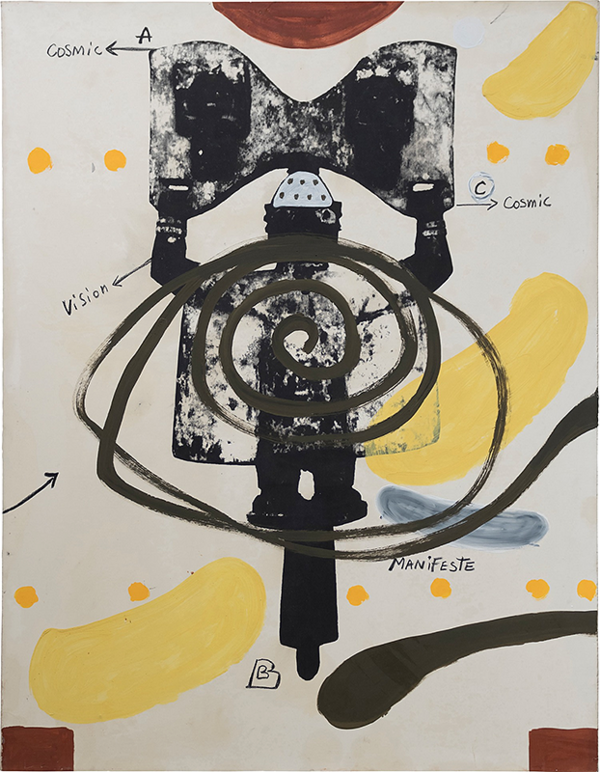Georg Baselitz, Dr. Dumouchel (Remix), 2007. 20th Century & Contemporary Art Evening Sale, London.
Georg Baselitz
Reflecting on his Remix paintings, Georg Baselitz has explained that “I try to retain one thing. The original stimulus. It was a different painter who did those earlier works. It was me, to be sure, but in a different spirit with a different intention.” Executed in 2007, the large-scale Dr. Dumouchel (Remix) is a key work from the series. Revisiting some of his most provocative compositions via photographs and catalogues, the German artist generated an innovative new body of work which addressed questions of permanence and change, originality and our relationship to history. This self-conscious approach to reference evokes an almost Hegelian approach to repetition: over time, and through the dialectic process of revisiting and recombining forms and negating others, Baselitz’s work continues to resolve itself. Featuring a caricature of Marcel Duchamp, Dr. Dumouchel (Remix) is an update of an earlier body of paintings, including Frisch verliebt – M. D, Melodie, and Im Walde von Blainville. In revising this motif over several iterations across the small series, Baselitz paired the amorous couple with patterned backgrounds that seem to nod to certain art historical touchstones: here, perhaps, a reference to another great self-revisionist, Edvard Munch, who returned to the purple-flecked wallpaper of his Weeping Women composition several times over his career.

Cecily Brown, Untitled, 2012. 20th Century & Contemporary Art Evening Sale, London.
Cecily Brown
Key to the musical concept of the remix is how the contemporary artist interprets their predecessors – something British painter Cecily Brown examines brilliantly in the dialogue struck between Untitled and a visual history of the female nude. As the artist explains, “You’ve got the same old materials – just oils and a canvas – and you’re trying to do something that’s been done for centuries. And yet, within those limits, you have to make something new or exciting.” The traditional nude ensemble gives Brown remarkable scope for a promiscuous blend of Old Master and Pop culture references, synthesized through the artist’s sensual textures. Taking clear pleasure in the physical properties of oil paint itself, Brown transforms her canvases into restless and shifting surfaces that hover between figuration and abstraction, producing fluid forms that combine the fleshy excess of Peter Paul Rubens and the gestural immediacy of Willem de Kooning. This approach eschews critical distance in favor of immediacy, encountering these traditional images and their creators head-on with new, reimagined significance.

Sarah Ball, Untitled, 2017. 20th Century & Contemporary Art Day Sale, London.
Sarah Ball
An underappreciated aspect of any remix is rediscovery, and a constituent element of that rediscovery stems from an artist finding the universal appeal of something which was previously forgotten, disused, or out of favor. It is often the process by which life returns to what never had time to become a ghost, and this alchemy is readily apparent in Sarah Ball’s phantasmic work. Her portraits of anonymous sitters feature evasive, implacable facial expressions. Her choice of muted palettes and monochrome backgrounds work in contrast to the presence of her subjects, which the artist often sources from newspaper archives and social media. This ambiguity between time and space, together with the way Ball renders their features – some in lifelike detail, some blended into the background – gives an otherworldly feel to her work, and yet, still retains the human elements that transcend their stillness. The male figure in Untitled comes to us from an old baseball card, a family photograph in the attic, or an immigration card, and his past and future are a mystery to the viewer, but given its almost archetypical style, we can layer our own narratives over the image, creating an identity that Ball’s practice compels us to confront – how the uncanny comes about is just as much a cultural reference point as how we interpret it.

Elizabeth Peyton, Evan at the Reading Festival 1993, 1997. 20th Century & Contemporary Art Evening Sale, London.
Elizabeth Peyton
A portrait of Evan Dando, the frontman of ‘90s grunge band the Lemonheads, Evan at the Reading Festival 1993 is emblematic of Elizabeth Peyton’s lyrical work. Incorporating sweeping brushwork, intimate sincerity, and emotional verve, the work collapses distinctions between realism and expressionist styles, and also between the public performance of celebrity and the deeply personal relationships that we forge with them. One of several portraits of Dando, he is shown here quietly contemplative, his long hair swept from his luminous face as he reads from the red book in his hands. Elbows leaning on crossed legs, his shoulders gently curved in concentration it is an image of quiet introspection and unguarded honesty that takes on the ethereal quality of a Pre-Raphaelite masterpiece. Using second-had images of our most iconic musicians, Peyton’s approach to her compositions suits this musical analogy, remixing her found material in new, personally meaningful ways. Peyton’s use of celebrities as idealized forms brilliantly discerns no real distinction between those she knows personally and those she knows from history. Classical art, particularly the mythmaking aspect of sublime but fictional subjects, creates larger-than-life fantasy, whereas Peyton brings the living legend – the rock star – and places them in their cultural milieu in a quiet, unshrouded manner, far from Andy Warhol’s fascination with celebrity, or the unimaginable perfection of the Pre-Raphaelite model in favor of history and its place in the now. “[People] are the way the world moves,” she explains, “and they contain their time.”

Emily Mae Smith, Raft on Siren Sea, 2017. 20th Century & Contemporary Art Evening Sale, London.
Emily Mae Smith
Placing itself in direct dialogue with the fin de siècle arts periodical The Studio through the appropriation of its title and typeface, Raft on Siren Sea highlights American artist Emily Mae Smith’s subversive response to established art historical narratives with another element of remixing that requires a mix of deft skill and clarity of purpose: the parody. The work blends the graphic quality of Surrealism and the Chicago Imagists in a manner that feeds into Smith’s distinctive brand of “feminist pop,” which employs sharp humor as a means of deflating and reframing assumptions related to women, class, and divisions between high and low culture. Smith notes: “ […] instead of going with whatever the canon of art history says, I actually just developed deeply personal relationships with specific paintings, giving them my read. In a sense my paintings are a response to these paintings and the web of social, cultural and emotional weight they carry instead of a reference to them.” Smith's siren is able to move across art historical space and time, parodying the narratives she finds there and rewriting them in her own visual style. Sailing under a silent moon, at first glance the ship here seems empty, the lapping waves driving it on. Upon closer inspection though, we see the sea itself contains the unmistaken forms of female bodies, the rise and fall of the waves echoing a feminine silhouette. Replacing the hero Odysseus and his all-male crew, Smith places a female protagonist at the helm, the literal and symbolic figurehead for an alternative version of this canonical story.

Ouattara Watts, Cosmic, 2002. 20th Century & Contemporary Art Day Sale, London.
Ouattara Watts
With Ouattara Watts’ work, the idea of remixing is baked into the conceptual basis of his practice – the Ivory Coast-born artist navigates a sea of cultures, symbols, patterns, numerals, and qualitative ideas not in search of, but rather in service to creating a universe on its own terms. “While I use identifiable pictorial elements to be better understood,” Watts notes, “this project is nevertheless about something much wider. I am painting the Cosmos.” There is a machine-like quality to the artist’s style, yet his figures of seemingly impractical items nurture a connective human aspiration, one that reveals the fundamental necessity of converging disparate images to create new landscapes. To Watts, the DJ and the metaphysician are exploring the same ideas; as are the skull or the chandelier or the flower in the artist’s system of objects. In Cosmic, Watts diagrams a darkened, mysterious figure with humanlike dimensions and several points of output with labels such as “Vision” and “Manifest” – and there is an unidentified input source, marked by its direction but its prompt just out of the scope of the canvas, coming from elsewhere in Watts’ interconnected macrocosm, almost in the form of an unsolved formula. There is always an unknown quantity which invites the remix to occur in the first place, and the artist experiments with any and all possibilities in order to arrive at the latest reach of the cosmos.
Discover More from 20th Century & Contemporary Art >
Recommended Reading
